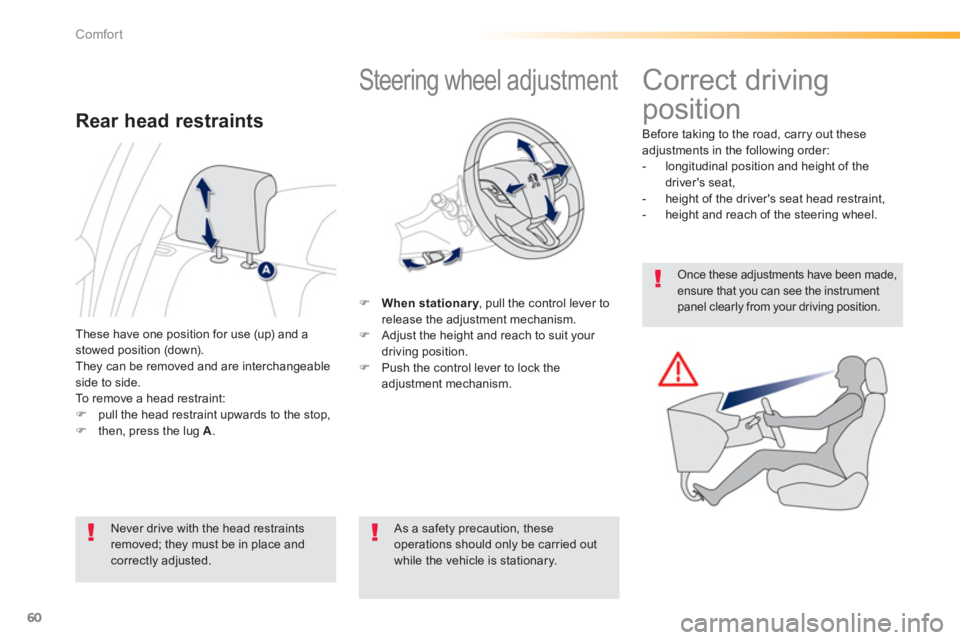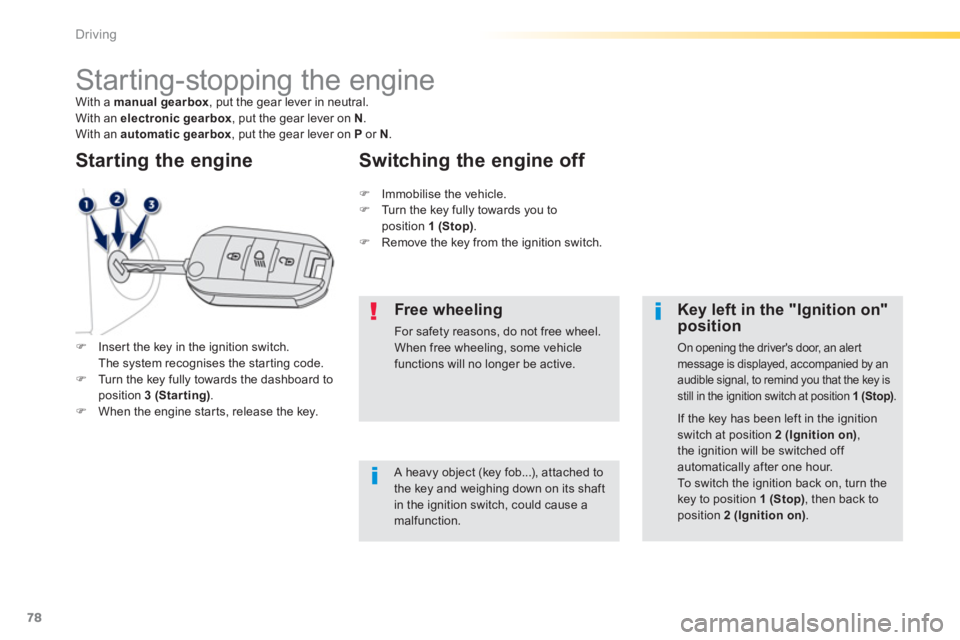Page 4 of 324

.
.
Contents
Instrument panels 21
Indicator and warning lamps 23
Gauges and indicators 33
Tr i p c o m p u t e r 38
Tr ip computer with touch screen 40
Setting the date and time 43
Instruments and controlsFamiliarisation
Remote control key 44
Alarm 5
1
Electric windows 53
Boot 55
Panoramic sunroof 56
Access
Front seats 57
Rear seats 59
Steering wheel adjustment 60
Mirrors 61
Ventilation 63
Heating 65
Manual air conditioning 65
Dual-zone digital air conditioning 67
Rear screen demist - defrost 70
Interior fi ttings 71
Boot fi ttings 75
Comfort
Starting-stopping the engine 78
Manual parking brake 79
Manual gearbox 80
5-speed electronic gearbox 81
6-speed electronic gear control gearbox 84
Automatic gearbox 88
Gear shift indicator 91
Stop & Star t 92
Hill star t assist 95
Speed limiter 96
Cruise control 98
Parking sensors 101
Park Assist 103
Driving
Lighting controls 107
LED lamps 111
Daytime running lamps 111
Automatic illumination of headlamps 113
Headlamp adjustment 114
Cornering lighting 115
Wiper controls 116
Automatic rain sensitive wipers 118
Courtesy lamps 120
Interior mood lighting 121
Visibility Eco-driving
Page 5 of 324

.
.
Contents
Direction indicators 122
Hazard warning lamps 122
Emergency or assistance call 123
Horn 123
ESP system 124
Grip control 127
Front seat belts 129
Airbags 132
Child seats 136
ISOFIX child seats 141
Child lock 144
Safety
Te m p o r a ry puncture repair kit 145
Changing a wheel 151
Snow chains 158
Changing a bulb 159
Changing a fuse 166
Battery 172
Electrical energy economy mode 175
Changing a wiper blade 176
To w i ng the vehicle 177
To w i ng a trailer 179
Fitting roof bars 181
Advice on care and maintenance 181
Accessories 182
Practical information
Bonnet 185
Petrol engines 186
Diesel engines 187
Fuel tank 188
Misfuel prevention (Diesel) 190
Running out of fuel (Diesel) 192
Checking levels 193
Checks 196
Checks
Petrol engines 198
Petrol weights 199
Diesel engines 200
Diesel weights 202
Dimensions 205
Identifi cation markings 206
Technical data
Emergency or assistance 207
Touch screen 209
Audio system / Bluetooth 269
Audio system 295
Audio equipment and telematics
Visual search
Alphabetical index
Page 10 of 324

8
Familiarisation
11.Front side window demisting/defrosting
vent.
12.Instrument panel.
13
. Windscreen demisting/defrosting vent. 14 .
Sunshine sensor.
15. Glove box / Passenger's airbagdeactivation.
16.Passenger's airbag.
17. Multifunction screen / Audio system.
18. Central adjustable air vents.
19.Central locking and hazard warningbuttons.
Instruments and controls
1. Cruise control / speed limiter controls. 2.
Steering mounted controls for the touch screen.
3.
Lighting and direction indicator stalk4.
Wiper / screenwash / trip computer stalk. 5.
Bonnet release lever.
6.Steering wheel adjustment control.
7. Driver's airbag.
Horn. 8.Headlamp height adjustment. 9. Switch panel. 10.Side adjustable air vents.
20.
Heating / air conditioning controls.21.12 V accessory socket.
USB por t / auxiliary socket.
Additional USB port.
22. Open storage.
Cup holder. 23. Gear lever. 24.
Grip control switch. 25.Parking brake.26.Panoramic sunroof blind opening andclosing control. 27.
Closed storage compar tment. 28.
Rear 12 V socket.
Page 13 of 324
.
11
Familiarisation
Sitting comfortably
Head restraint adjustment
58
1.Release the adjustment mechanism.
2. Adjust for height and reach. 3.
Lock the adjustment mechanism.
Steering wheel adjustment
60
For reasons of safety, these operationsmust only be carried out with thevehicle stationary.
Heated seats control
0:
off.
1:low. 2: medium. 3:high. To raise the head restraint, pull it upwards.
To lower it, press the lu
g A
and down on thehead restraint at the same time.
5
8
Page 22 of 324

20
Familiarisation
Limit the causes of excess consumption
Spread loads throughout the vehicle; place the heaviest items in thebottom of the boot, as close as possible to the rear seats.
Limit the loads carried in the vehicle and reduce wind resistance (roof bars, roof rack, bicycle carrier, trailer...). Use a roof box in preference.
Remove roof bars and roof racks after use.
At the end of winter, remove snow tyres and refit your summer tyres.
Observe the recommendations on
maintenance
Check the tyre pressures regularly, when cold, referring to the label in the door aperture, driver's side. Carry out this check in par ticular:
- before a long journey,
- at each change of season,
- after a long period out of use.
Don't forget the spare wheel and the tyres on any trailer or caravan.
Have your vehicle ser viced regularly (engine oil, oil filter, air filter...) andobser ve the schedule of operations recommended by the manufacturer.
When refuelling, do not continue after the third cut-off of the nozzle toavoid any overflow.
At the wheel of your new vehicle, it is only after the first 1 800 miles (3 000 kilometres) that you will see the fuel consumption settle down toa consistent average.
Page 41 of 324
1
39
Instruments and controls
Tr ip reset
�)When the trip required is displayed, press
the control for more than two secondsor use the left hand thumb wheel of the steering mounted controls.
Trips "1"
and "2"are independent but their useis identical.
For example, trip "1"
can be used for daily figures, and trip "2"
for monthly figures.
Page 62 of 324

60
Comfort
Steering wheel adjustment
�)When stationary, pull the control lever toyrelease the adjustment mechanism.�)
Adjust the height and reach to suit your
driving position.�) Push the control lever to lock the
adjustment mechanism.
As a safety precaution, these operations should only be carried outwhile the vehicle is stationary. These have one position for use
(up) and a stowed position (down).
They can be removed and are interchangeableside to side.To remove a head restraint:�)pull the head restraint upwards to the stop, �)then, press the lug A .
Rear head restraints
Never drive with the head restraints removed; they must be in place and correctly adjusted.
Correct driving
position
Before taking to the road, carry out these
adjustments in the following order:
- longitudinal position and height of the
driver's seat,
- hei
ght of the driver's seat head restraint,
- height and reach of the steering wheel.
Once these adjustments have been made,ensure that you can see the instrument panel clearly from your driving position.
Page 80 of 324

78
Driving
Starting-stopping the engine With a manual gearbox, put the gear lever in neutral.
With an electronic gearbox , put the gear lever on N
.
With an automatic gearbox , put the gear lever on P
or N.
�)Inser t the key in the ignition switch.
The system recognises the star ting code. �)Turn the key fully towards the dashboard toposition 3 (Starting).�)When the engine starts, release the key.
Starting the engine
A heavy object (key fob...), attached tothe key and weighing down on its shaft in the ignition switch, could cause amalfunction.
Key left in the "Ignition on"position
On opening the driver's door, an aler t message is displayed, accompanied by an audible signal, to remind you that the key isstill in the ignition switch at position 1 (Stop).
�)
Immobilise the vehicle.�)
Turn the key fully towards you to
position 1 (Stop).�) Remove the key from the ignition switch.
Switching the engine off
If the key has been left in the ignition
switch at position 2 (Ignition on),the ignition will be switched off automatically after one hour.
To switch the ignition back on, turn the key to position 1 (Stop)
, then back toposition 2 (Ignition on).
Free wheeling
For safety reasons, do not free wheel.
When free wheeling, some vehicle functions will no longer be active.